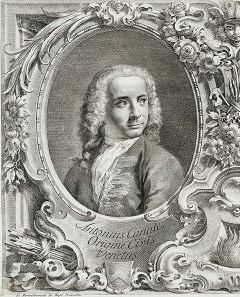

It's almost impossible talking about art in Venice in the XVIII century and not talk about Antonio Canal, known as Il Canaletto (the small canal).
He very likely received this name so he wouldn't be confused with his father when they worked together doing theatrical scene paintings in Rome. Canal ... Canaletto.
Canaletto's art has definitely nothing to do with Carnival, because his work was concentrated on describing the city, but it is so extended, nice and important - in several ways - that he was and still is a mark on the city.
And he's the one who really "photographed" the Venice of his century.
You will find about a thousand images of his work and of other Vedutisti (View Painters) of the XVIII century, on my other website www.antoniocanal.com.
Canaletto built, in the Venice of the XVIII century, an art franchise (his studio) to submit and spread the beauty of Venice in the known world. For money, of course, it was his profession after all, the "artist" concept is a modern concept our society has created.
And his nephew Bernardo Bellotto (1721/2-1780) - highly skilled too - cooperated and continued his art business with so much equivalent skill that there still are doubts about who painted what.
And we are talking about around 900 big canvases, all the capricci (imagined views of places, mixing real monuments and imagining situations) plus all the rest, hundreds of drawings, quite a remarkably large production.
Canaletto died 70 years old, and on a drawing he made in 1766 - aged 68 - he wrote a commentary about still being in good shape:
"Io Zuane Antonio da Canal, Hò fatto
il presente disegnio, delli Musici che canta
nella Chiesa Ducal di S.Marco in Venezia
in ettà de Anni 68 Cenzza Ochiali, Lanno 1766."
"I, Giovanni Antonio of the Canal, have made
this drawing, of the musicians who sing
in the Ducal Church of St. Mark in Venice
with the age of 68 years without glasses,
in the year 1766."
Which shows how his eyesight had been performing extraordinarily well all his life.
He had for sure a very sharp vision and a strong visual memory to retain all details he would put in his paintings.
No need of a camera obscura, it would have been just a waste of energy and time for somebody with such a perfect sense of space like him.
Notwithstanding, Anton Maria Zanetti - who is very frequently related as "Canaletto's biographer" - in the two pages he dedicates to Canaletto in his 1771 book "Della pittura veneziana e delle opere pubbliche de' veneziani maestri" (Of Venetian painting and public works of Venetian Masters), suggests that Canaletto was making use of a Camera Obscura to create his views.
Anton Maria Zanetti's words here:
"Insegnò il Canal con l'esempio il vero uso della camera ottica; e a conoscere i difetti che recar suole a una pittura, quando l'artefice interamente si fida della prospettiva che in essa camera vede, e delle tinte spezialmente delle arie e non sa levar destramente quanto può offendere il senso.
Il Professore m' intenderà."
"Canaletto taught with his example, the real use of the optical camera; and to understand all the defects which it gives to a painting, when the artist fully trusts the perspective which he sees in the camera, and of the colors of special situations and is not able to deftly take out what could be offensive to the senses.
The Professor will understand me."





